Midweek Review
AKD in dilemma over anti-terror laws he used to condemn
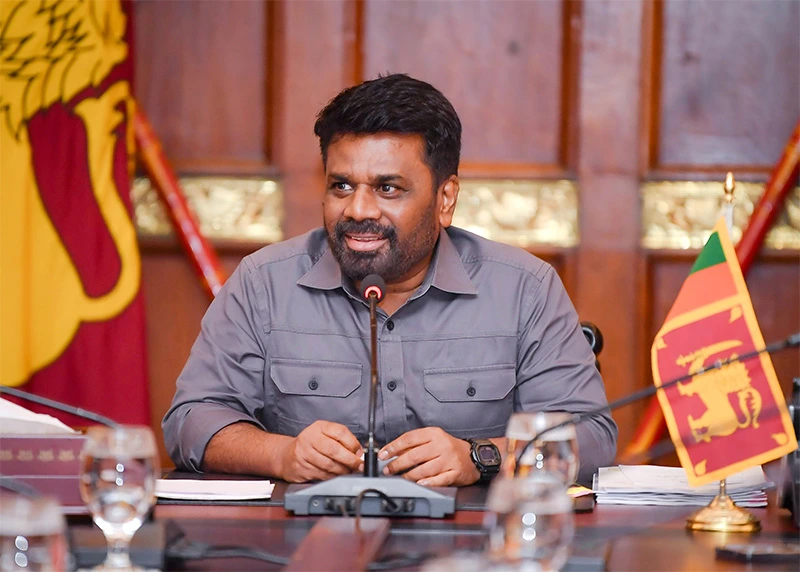
President Dissanayake’s government promptly utilized the PTA – the first since the presidential election – to deal with those who had been suspected of allegedly planning to mount an attack on Israelis in the Arugam Bay area. The government couldn’t have ignored the alleged threat, especially against the backdrop of the warning issued by the US Embassy here, of what it called a serious risk. In line with the statement, dated Oct. 23, the Embassy imposed travel restrictions on mission personnel as well, while strongly urging US passport holders to avoid the area.
By Shamindra Ferdinando
The Prevention of Terrorism Act (PTA/No 48 of 1979)) that had been introduced in 1979 as a temporary measure by President JRJ in response to emerging threats from separatist terrorists and made into a permanent law in 1982 (No 10 of 1982) attracted considerable public attention over the past few weeks in the wake of the police making arrests under this draconian law.
The issue at hand should be freshly examined against the backdrop of the Janatha Vimukthi Peremauna (JVP), the dominant partner in the newly elected National People’s Power (NPP), having been at the receiving end of that piece of controversial legislation in the ’80s, particularly during their second violent uprising (1987-1990 period).
The JVP constantly demanded the repealing of the PTA at a time the party never dreamt of an opportunity to win a national election under any circumstances. In fact, the abolition of the PTA had been one of the JVP’s main demands throughout the war/insurgency and thereafter. However, now that the JVP-led NPP having had convincingly won the presidential (Sept. 21) and general (Nov. 14) elections and is in the process of consolidating its power, the powers that be have no option but to revisit its previous highly critical stand on the controversial Act.
Can President Anura Kumara Dissanayake, who is also the Commander-in-Chief of the armed forces, in addition to being the Defence Minister, as well as head of the National Security Council (NSC), do without the PTA.
Can the PTA be abolished and whatever existing/future security threats be dealt with other relevant laws, or replaced with a new law acceptable to all political parties represented in Parliament. But, that does not mean that concerns of those outside Parliament should be discarded without proper examination.
President Dissanayake’s government promptly utilized the PTA – the first since the presidential election – to deal with those who had been suspected of allegedly planning to mount an attack on Israelis in the Arugam Bay area. The government couldn’t have ignored the alleged threat, especially against the backdrop of the warning issued by the US Embassy here, of what it called a serious risk. In line with the statement, dated Oct. 23, the Embassy imposed travel restrictions on mission personnel as well, while strongly urging US passport holders to avoid the area.
The government had no option but to invoke the PTA again to deal with those who sought to humiliate the administration over the Mahaveer Naal events conducted in the Northern and Eastern provinces in memory of LTTE leader Velupillai Prabhakaran’s birthday.
Responding to the Mahaveer Naal events, Public Security and Parliamentary Affairs Minister Ananda Wijepala, first time entrant to Parliamen, accused Opposition activists of exploiting the situation to undermine the government. Wijepala, who had served as Anura Kumara Dissanayake’s private secretary when he served as a lawmaker, alleged that the involvement of the New Democratic Front (NDF) in the conspiracy, while shortly, thereafter, law enforcement authorities arrested the administrative secretary of the SLPP, Renuka Perera, for allegedly disseminating false information with regard to Mahaveer Naal.
It would be pertinent to mention that not all those who were apprehended for disseminating such false information been taken in under the PTA.
The issue is whether the government needs a draconian law, like the PTA, to deal with persons circulating videos of LTTE events during the conflict and after.
Apprehending people for circulating videos of such events seemed ridiculous when the Illankai Thamil Arasu Kadchi (ITAK), having recognized the LTTE as the sole representative of the Tamil-speaking people, received an audience with no less a person than President Dissanayake. The meeting between President Dissanayake and the ITAK delegation took place at the Presidential Secretariat amidst the continuing furore over people being arrested for circulating Mahaveer Naal content. Some of the ITAK members recently had paid tribute to the LTTE publicly while the government struggled to deal with bad press over Mahaveer Naal events.
The writer is of the view that commemoration of LTTE cadres should be permitted, regardless of their status. In fact, such events underscored the futility of the LTTE macabre cause. Mahaveer Naal automatically reminds the country of the atrocities that had been perpetrated by the LTTE over the years until their very end on the Vanni east front.
Let me remind those shedding crocodile tears for terrorists of the cold blooded killing of academic Rajani Thiranagama in Jaffna in late Sept 1989 during the deployment of the IPKF. Dr. Thiranagama was shot dead on Sept. 21 while cycling home from the Jaffna University, where she was Head of the Anatomy Department.
Yahapalana
bid to repeal PTA
While in the Opposition, Ranil Wickremesinghe relentlessly campaigned against the PTA. Wickremesinghe had an opportunity to explore the possibility of doing away with the PTA after he facilitated Maithripala Sirisena’s victory at the 2015 presidential election. Wickremesinghe’s broken promise due to delaying of the required action, should be discussed, taking into consideration Western governments’ unbending interest in abolition of the PTA. They felt that in the aftermath of the LTTE’s eradication, Sri Lanka didn’t require such a law.
Since the successful conclusion of the war in May 2009, the Western governments had been putting pressure on war-winning President Mahinda Rajapaksa to abolish the PTA. The JVP, too, backed the Western call to do away with emergency regulations and the PTA. However, President Rajapaksa resisted relentless Western pressures but the Yahapalana government initiated a high profile project to do away with the PTA over a year after the 2015 January presidential election.
Instead of doing away with the PTA as demanded by various interested parties, Wickremesinghe sought to replace the existing law with what he called the Counter Terrorism Act (CTA).
The committee that had been tasked with drafting the policy and legal framework of the proposed law was headed by Sagala Ratnayake, Minister of Law and Order and Southern Development. Obviously Wickremesinghe couldn’t have done away with the PTA without taking adequate provisions to counter terrorism. Wickremesinghe subjected the whole process to the scrutiny of Western governments. Among those invited for discussions on the CTA and an Amendment to the Code of Criminal Procedure Act on Dec. 16, 2016, were Justice Minister Wijeyadasa Rajapakse, Minister Sagala Ratnayake, British High Commissioner James Dauris, French Ambassador Jean-Marin Schus, EU Ambassador Tung-Lai Margue and several other foreign envoys.
However, the Yahapalana government couldn’t go ahead with the project. Wickremesinghe couldn’t muster the required support for his move as the Yahapalana parliamentary group gradually fell apart. By late 2017, the relationship in the coalition between the UNP and Maithripala Sirisena’s SLFP had deteriorated to such an extent, agreement on such a significant piece of proposed legislation seemed very much unlikely. Their decision to go it alone at Local Government elections in early February 2018 sealed the fate of the Yahapalana alliance, and the much touted bid to introduce CTA in place of the PTA, fizzled out.
The Sirisena-Wickremesinghe alliance had been in turmoil since Wickremesinghe’s nominee for the post of Governor Central Bank, Singaporean Arjuna Mahendran, perpetrated the massive Treasury bond scams in Feb. 2015 and March 2016. The humiliating defeat suffered by both the UNP and the SLFP at the Local Government polls effectively ended their partnership while the CTA was put on the back burner. The government had been in such a desperate situation, the top leadership simply could not deal with the CTA and the matter was quickly forgotten.
Having neglected national security to their heart’s content, the UNP leadership relaunched the CTA project in the wake of the 2019 Easter Sunday carnage. The UNP saw an opportunity to pressure political parties represented in Parliament, as well as other interested parties, over the proposed CTA. However, Wickremesinghe’s move hadn’t received much anticipated support as those who opposed the PTA alleged that the new law never really changed the powers granted to law enforcement authorities.
In spite of the Easter Sunday attacks, the opposition to the PTA, and the proposed CTA, remained unyielding. Political parties, civil society and Western governments haven’t been able to reach consensus on anti-terrorism law legislation though all post-war administrations discussed the issues at hand at length.
President Gotabaya Rajapaksa, too, made an effort to amend the PTA. In late January 2022, President Rajapaksa’s Cabinet approved a spate of amendments to the PTA. But, the proposed amendments failed to secure the backing of those concerned about anti-terrorism law. The introduction of amendments meant that President Rajapaksa had absolutely no interest in at least examining Wickremesinghe’s brainchild CTA.
The civil society, legal scholars and other interested parties simply rejected the amendments on the basis the government failed to address their long standing concerns. The Rajapaksa administration in Dec. 2019 withdrew Wickremesinghe’s proposed Counter terrorism Bill to pave the way for a new initiative that was launched in June 2021. Obviously, it hadn’t been a priority for the Rajapaksa administration though under Foreign Minister Prof. G. L. Peiris’s leadership a Cabinet subcommittee deliberated a report prepared by Defence Secretary Gen. Kamal Gunaratne. That bid, too, failed and during Wickremesinghe’s presidency (July 2022-Sept 2024) nothing really happened with regard to the PTA.
New challenges
The European Union has linked the repeal of the PTA with its continuing relationship with Sri Lanka. The EU, in Oct. 2021 during Gotabaya Rajapaksa’s presidencyk told Sri Lanka that the country must amend the PTA that gave law enforcement authorities sweeping powers to arrest and hold suspects, without trial, if it wanted to retain the lucrative GSP-plus trade status with the 27-member economic bloc.
President Dissanayake now faced the daunting task of addressing the concerns of the EU and various other members of the Western world with regard to anti-terrorism laws here.
Dissanayake’s administration cannot ignore the renewed calls for the abolition of the PTA or the introduction of suitable amendments. However, the government cannot weaken Sri Lanka’s defences against terrorism though the LTTE rump is unlikely to pose a conventional military threat. But, the 2019 Easter Sunday carnage proved responsibility on the part of the government to ensure the armed forces, the police and intelligence services had legal safeguards when dealing with terrorism.
*One of the major shortcomings in the amendments proposed by President Gotabaya Rajapaksa, according to civil society groups, is the failure on the part of the amended Bill to address problems with the admissibility of statements and confessions under the PTA. They have repeatedly pointed out provisions of the PTA waived the application of the Evidence Ordinance and there were no safeguards to be followed in recording confessions and statements from suspects.
*Another issue of concern is that the period of 72 hours after arrest and before production before a magistrate had not been amended. They have declared this is a loophole in the PTA that facilitated the torture of those arrested under the PTA while in custody.
*They are also concerned about the absence of sufficient judicial oversight during investigations conducted in terms of the PTA.
*As the definition of the acts which came within the offence of terrorism is of a broad and vague nature, those in authority tend to abuse the PTA. The amendments that had been approved by Gotabaya Rajapaksa’s Cabinet in January 2022 hadn’t addressed concerns expressed by interested parties.
The above were some of the concerns raised by those demanding abolition of the PTA/suitable amendments to the law. Anti-terrorism laws in force in all countries regardless of their status always attract public criticism and can be described as a source of intense debate. Critics say that anti-terrorim laws violate even the basic freedoms enjoyed by the people.
Neighbouring India employs a spate of laws meant to deal with terrorism. Amendments have been introduced over the years and like here these laws have been abused though stakeholders accept the need for tough anti-terrorism laws to meet security challenges. India has gone to the extent of neutralizing those living overseas in case New Delhi felt they posed a threat. The ongoing controversy involving India and Canada over the alleged hit ordered by New Delhi in Vancouver is a case in point.
Sri Lanka, under any circumstances, cannot afford to do away with the PTA altogether. However, the government, in consultation with political parties represented in Parliament, should take tangible measures to ensure law enforcement didn’t deliberately abuse PTA for political or private purposes. There is no point in denying the fact that the PTA had been grossly abused over the years by all governments. Perpetrators hadn’t been properly dealt with thereby creating an environment for such abuses. However, the PTA had provided invaluable support for law enforcement operations as successive governments battled Northern and Southern terrorists.
During the war against the LTTE, the PTA had been a critical part of the government arsenal. Interrogation of suspects had been part of the overall security strategy meant to thwart attacks as law enforcement authorities battled LTTE terrorists assigned for covert operations in the South and especially suicide bombings.
Terrorist infiltration couldn’t have been averted without continuous operations, based on available information. The government had no option but to discourage people from the Northern and Eastern provinces from taking up residence in Colombo and its suburbs, as well as other predominantly Sinhala areas, as part of the overall measures to neutralize the threats on soft targets.
The LTTE targeted public transport in a bid to mount pressure on the government as it was retreating on the battlefield.
In spite of allegations of its misuse and abuse, the PTA had been quite useful in combating Southern and Northern terrorism. That is the undeniable truth. Whatever its shortcomings, the PTA cannot be done away with unless the government introduces a new anti-terrorism law that meets security requirements, in a challenging environment.
Though the West impose pressure on countries like Sri Lanka to undo such laws, they themselves have introduced even much harsher laws like the Homeland Security Act 2002 passed by the USA, primarily in reaction to the 9/11 attacks there, in the previous year, by Muslim terrorists, that claimed few thousand lives and somewhat similar draconian laws were introduced in England after the bomb attacks in London soon afterwards. But there is hardly a whimper from our Foreign Ministry that generally plays deaf and dumb like our diplomats about such unfair demands from us by the West.
Features
Handunnetti and Colonial Shackles of English in Sri Lanka
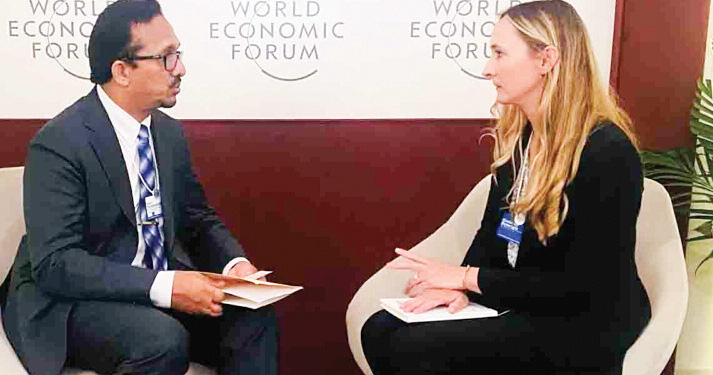
“My tongue in English chains.
I return, after a generation, to you.
I am at the end
of my Dravidic tether
hunger for you unassuaged
I falter, stumble.”
– Indian poet R. Parthasarathy
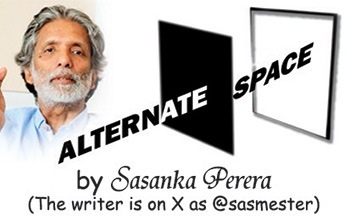 When Minister Sunil Handunnetti addressed the World Economic Forum’s ‘Is Asia’s Century at Risk?’ discussion as part of the Annual Meeting of the New Champions 2025 in June 2025, I listened carefully both to him and the questions that were posed to him by the moderator. The subsequent trolling and extremely negative reactions to his use of English were so distasteful that I opted not to comment on it at the time. The noise that followed also meant that a meaningful conversation based on that event on the utility of learning a powerful global language and how our politics on the global stage might be carried out more successfully in that language was lost on our people and pundits, barring a few commentaries.
When Minister Sunil Handunnetti addressed the World Economic Forum’s ‘Is Asia’s Century at Risk?’ discussion as part of the Annual Meeting of the New Champions 2025 in June 2025, I listened carefully both to him and the questions that were posed to him by the moderator. The subsequent trolling and extremely negative reactions to his use of English were so distasteful that I opted not to comment on it at the time. The noise that followed also meant that a meaningful conversation based on that event on the utility of learning a powerful global language and how our politics on the global stage might be carried out more successfully in that language was lost on our people and pundits, barring a few commentaries.
Now Handunnetti has reopened the conversation, this time in Sri Lanka’s parliament in November 2025, on the utility of mastering English particularly for young entrepreneurs. In his intervention, he also makes a plea not to mock his struggle at learning English given that he comes from a background which lacked the privilege to master the language in his youth. His clear intervention makes much sense.
The same ilk that ridiculed him when he spoke at WEF is laughing at him yet again on his pronunciation, incomplete sentences, claiming that he is bringing shame to the country and so on and so forth. As usual, such loud, politically motivated and retrograde critics miss the larger picture. Many of these people are also among those who cannot hold a conversation in any of the globally accepted versions of English. Moreover, their conceit about the so-called ‘correct’ use of English seems to suggest the existence of an ideal English type when it comes to pronunciation and basic articulation. I thought of writing this commentary now in a situation when the minister himself is asking for help ‘in finding a solution’ in his parliamentary speech even though his government is not known to be amenable to critical reflection from anyone who is not a party member.
The remarks at the WEF and in Sri Lanka’s parliament are very different at a fundamental level, although both are worthy of consideration – within the realm of rationality, not in the depths of vulgar emotion and political mudslinging.
The problem with Handunnetti’s remarks at WEF was not his accent or pronunciation. After all, whatever he said could be clearly understood if listened to carefully. In that sense, his use of English fulfilled one of the most fundamental roles of language – that of communication. Its lack of finesse, as a result of the speaker being someone who does not use the language professionally or personally on a regular basis, is only natural and cannot be held against him. This said, there are many issues that his remarks flagged that were mostly drowned out by the noise of his critics.
Given that Handunnetti’s communication was clear, it also showed much that was not meant to be exposed. He simply did not respond to the questions that were posed to him. More bluntly, a Sinhala speaker can describe the intervention as yanne koheda, malle pol , which literally means, when asked ‘Where are you going?’, the answer is ‘There are coconuts in the bag’.
He spoke from a prepared text which his staff must have put together for him. However, it was far off the mark from the questions that were being directly posed to him. The issue here is that his staff appears to have not had any coordination with the forum organisers to ascertain and decide on the nature of questions that would be posed to the Minister for which answers could have been provided based on both global conditions, local situations and government policy. After all, this is a senior minister of an independent country and he has the right to know and control, when possible, what he is dealing with in an international forum.
This manner of working is fairly routine in such international fora. On the one hand, it is extremely unfortunate that his staff did not do the required homework and obviously the minister himself did not follow up, demonstrating negligence, a want for common sense, preparedness and experience among all concerned. On the other hand, the government needs to have a policy on who it sends to such events. For instance, should a minister attend a certain event, or should the government be represented by an official or consultant who can speak not only fluently, but also with authority on the subject matter. That is, such speakers need to be very familiar with the global issues concerned and not mere political rhetoric aimed at local audiences.
Other than Handunnetti, I have seen, heard and also heard of how poorly our politicians, political appointees and even officials perform at international meetings (some of which are closed door) bringing ridicule and disastrous consequences to the country. None of them are, however, held responsible.
Such reflective considerations are simple yet essential and pragmatic policy matters on how the government should work in these conditions. If this had been undertaken, the WEF event might have been better handled with better global press for the government. Nevertheless, this was not only a matter of English. For one thing, Handunnetti and his staff could have requested for the availability of simultaneous translation from Sinhala to English for which pre-knowledge of questions would have been useful. This is all too common too. At the UN General Assembly in September, President Dissanayake spoke in Sinhala and made a decent presentation.
The pertinent question is this; had Handunetti had the option of talking in Sinhala, would the interaction have been any better? That is extremely doubtful, barring the fluency of language use. This is because Handunnetti, like most other politicians past and present, are good at rhetoric but not convincing where substance is concerned, particularly when it comes to global issues. It is for this reason that such leaders need competent staff and consultants, and not mere party loyalists and yes men, which is an unfortunate situation that has engulfed the whole government.
What about the speech in parliament? Again, as in the WEF event, his presentation was crystal clear and, in this instance, contextually sensible. But he did not have to make that speech in English at all when decent simultaneous translation services were available. In so far as content was concerned, he made a sound argument considering local conditions which he knows well. The minister’s argument is about the need to ensure that young entrepreneurs be taught English so that they can deal with the world and bring investments into the country, among other things. This should actually be the norm, not only for young entrepreneurs, but for all who are interested in widening their employment and investment opportunities beyond this country and in accessing knowledge for which Sinhala and Tamil alone do not suffice.
As far as I am concerned, Handunetti’s argument is important because in parliament, it can be construed as a policy prerogative. Significantly, he asked the Minister of Education to make this possible in the educational reforms that the government is contemplating.
He went further, appealing to his detractors not to mock his struggle in learning English, and instead to become part of the solution. However, in my opinion, there is no need for the Minister to carry this chip on his shoulder. Why should the minister concern himself with being mocked for poor use of English? But there is a gap that his plea should have also addressed. What prevented him from mastering English in his youth goes far deeper than the lack of a privileged upbringing.
The fact of the matter is, the facilities that were available in schools and universities to learn English were not taken seriously and were often looked down upon as kaduwa by the political spectrum he represents and nationalist elements for whom the utilitarian value of English was not self-evident. I say this with responsibility because this was a considerable part of the reality in my time as an undergraduate and also throughout the time I taught in Sri Lanka.
Much earlier in my youth, swayed by the rhetoric of Sinhala language nationalism, my own mastery of English was also delayed even though my background is vastly different from the minister. I too was mocked, when two important schools in Kandy – Trinity College and St. Anthony’s College – refused to accept me to Grade 1 as my English was wanting. This was nearly 20 years after independence. I, however, opted to move on from the blatant discrimination, and mastered the language, although I probably had better opportunities and saw the world through a vastly different lens than the minister. If the minister’s commitment was also based on these social and political realities and the role people like him had played in negating our English language training particularly in universities, his plea would have sounded far more genuine.
If both these remarks and the contexts in which they were made say something about the way we can use English in our country, it is this: On one hand, the government needs to make sure it has a pragmatic policy in place when it sends representatives to international events which takes into account both a person’s language skills and his breadth of knowledge of the subject matter. On the other hand, it needs to find a way to ensure that English is taught to everyone successfully from kindergarten to university as a tool for inclusion, knowledge and communication and not a weapon of exclusion as is often the case.
This can only bear fruit if the failures, lapses and strengths of the country’s English language teaching efforts are taken into cognizance. Lamentably, division and discrimination are still the main emotional considerations on which English is being popularly used as the trolls of the minister’s English usage have shown. It is indeed regrettable that their small-mindedness prevents them from realizing that the Brits have long lost their long undisputed ownership over the English language along with the Empire itself. It is no longer in the hands of the colonial masters. So why allow it to be wielded by a privileged few mired in misplaced notions of elitism?
Features
Finally, Mahinda Yapa sets the record straight
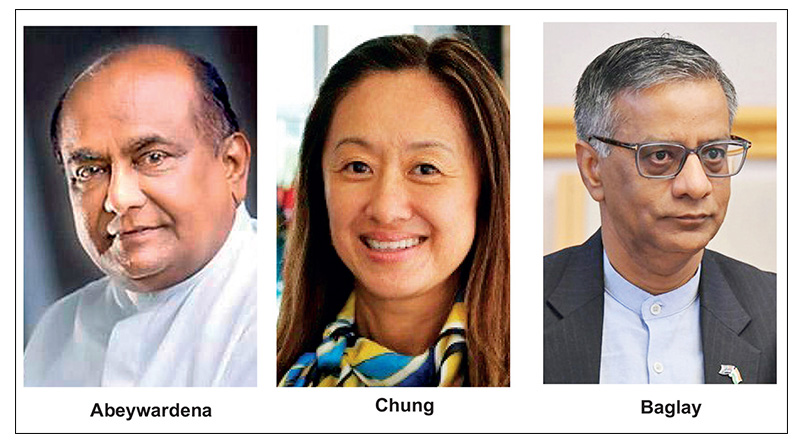
Clandestine visit to Speaker’s residence:
Finally, former Speaker Mahinda Yapa Abeywardena has set the record straight with regard to a controversial but never properly investigated bid to swear in him as interim President. Abeywardena has disclosed the circumstances leading to the proposal made by external powers on the morning of 13 July, 2022, amidst a large scale staged protest outside the Speaker’s official residence, situated close to Parliament.
Lastly, the former parliamentarian has revealed that it was then Indian High Commissioner, in Colombo, Gopal Baglay (May 2022 to December 2023) who asked him to accept the presidency immediately. Professor Sunanda Maddumabandara, who served as Senior Advisor (media) to President Ranil Wickremesinghe (July 2022 to September 2024), disclosed Baglay’s direct intervention in his latest work, titled ‘Aragalaye Balaya’ (Power of Aragalaya).
Prof. Maddumabandara quoted Abeywardena as having received a startling assurance that if he agreed to accept the country’s leadership, the situation would be brought under control, within 45 minutes. Baglay had assured Abeywardena that there is absolutely no harm in him succeeding President Gotabaya Rajapaksa, in view of the developing situation.
The author told the writer that only a person who had direct control over the violent protest campaign could have given such an assurance at a time when the whole country was in a flux.
One-time Vice Chancellor of the Kelaniya University, Prof. Maddumabandara, launched ‘Aragalaye Balaya’ at the Sri Lanka Foundation on 20 November. In spite of an invitation extended to former President Gotabaya Rajapaksa, the ousted leader hadn’t attended the event, though UNP leader Ranil Wickremesinghe was there. Maybe Gotabaya felt the futility of trying to expose the truth against evil forces ranged against them, who still continue to control the despicable agenda.
Obviously, the author has received the blessings of Abeywardena and Wickremesinghe to disclose a key aspect in the overall project that exploited the growing resentment of the people to engineer change of Sri Lankan leadership.
The declaration of Baglay’s intervention has contradicted claims by National Freedom Front (NFF) leader Wimal Weerawansa (Nine: The hidden story) and award-winning writer Sena Thoradeniya (Galle Face Protest: System change for anarchy) alleged that US Ambassador Julie Chung made that scandalous proposal to Speaker Abeywardena. Weerawansa and Thoradeniya launched their books on 25 April and 05 July, 2023, at the Sri Lanka Foundation and the National Library and Documentation Services Board, Independence Square, respectively. Both slipped in accusing Ambassador Chung of making an abortive bid to replace Gotabaya Rajapaksa with Mahinda Yapa Abeywardena.
Ambassador Chung categorically denied Weerawansa’s allegation soon after the launch of ‘Nine: The hidden story’ but stopped short of indicating that the proposal was made by someone else. Chung had no option but to keep quiet as she couldn’t, in response to Weerawansa’s claim, have disclosed Baglay’s intervention, under any circumstances, as India was then a full collaborator with Western designs here for its share of spoils. Weerawansa, Thoradeniya and Maddumabandara agree that Aragalaya had been a joint US-Indian project and it couldn’t have succeeded without their intervention. Let me reproduce the US Ambassador’s response to Weerawansa, who, at the time of the launch, served as an SLPP lawmaker, having contested the 2020 August parliamentary election on the SLPP ticket.
“I am disappointed that an MP has made baseless allegations and spread outright lies in a book that should be labelled ‘fiction’. For 75 years, the US [and Sri Lanka] have shared commitments to democracy, sovereignty, and prosperity – a partnership and future we continue to build together,” Chung tweeted Wednesday 26 April, evening, 24 hours after Weerawansa’s book launch.
Interestingly, Gotabaya Rajapaksa has been silent on the issue in his memoirs ‘The Conspiracy to oust me from Presidency,’ launched on 07 March, 2024.
What must be noted is that our fake Marxists, now entrenched in power, were all part and parcel of Aragalaya.
A clandestine meeting
Abeywardena should receive the appreciation of all for refusing to accept the offer made by Baglay, on behalf of India and the US. He had the courage to tell Baglay that he couldn’t accept the presidency as such a move violated the Constitution. In our post-independence history, no other politician received such an offer from foreign powers. When Baglay stepped up pressure, Abeywardena explained that he wouldn’t change his decision.
Maddumabandara, based on the observations made by Abeywardena, referred to the Indian High Commissioner entering the Speaker’s Official residence, unannounced, at a time protesters blocked the road leading to the compound. The author raised the possibility of Baglay having been in direct touch with those spearheading the high profile political project.
Clearly Abeywardena hadn’t held back anything. The former Speaker appeared to have responded to those who found fault with him for not responding to allegations, directed at him, by revealing everything to Maddumabandara, whom he described in his address, at the book launch, as a friend for over five decades.
At the time, soon after Baglay’s departure from the Speaker’s official residence, alleged co-conspirators Ven. Omalpe Sobitha, accompanied by Senior Professor of the Sinhala Faculty at the Colombo University, Ven. Agalakada Sirisumana, health sector trade union leader Ravi Kumudesh, and several Catholic priests, arrived at the Speaker’s residence where they repeated the Indian High Commissioner’s offer. Abeywardena repeated his previous response despite Sobitha Thera acting in a threatening manner towards him to accept their dirty offer. Shouldn’t they all be investigated in line with a comprehensive probe?
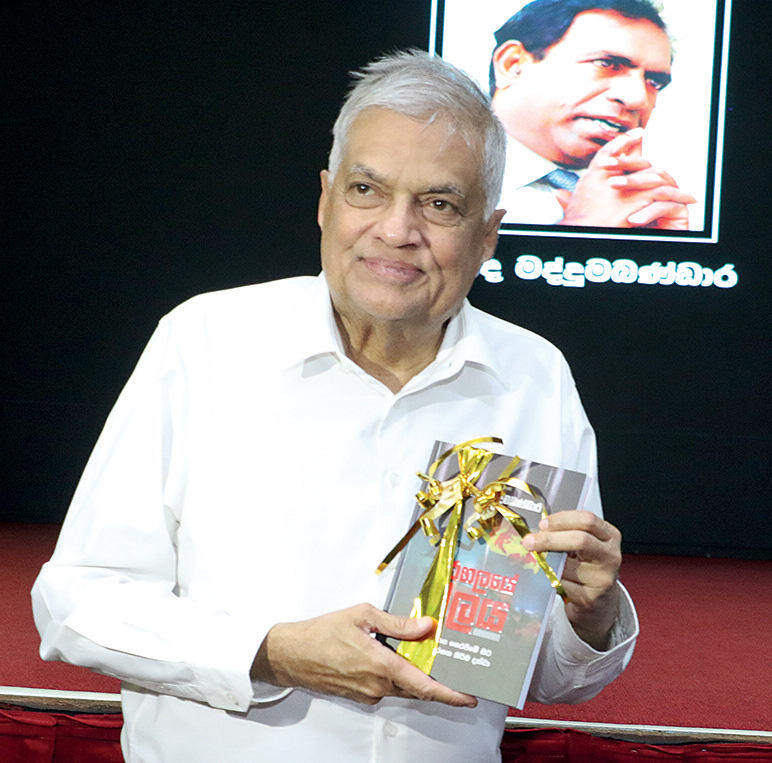
Ex-President Wickremesinghe with a copy of Aragalaye Balaya he received from its author, Prof. Professor Sunanda Maddumabandara, at the Sri Lanka Foundation recently (pic by Nishan S Priyantha)
On the basis of what Abeywardena had disclosed to him, Maddumabanadara also questioned the circumstances of the deployment of the elite Special Task Force (STF) contingent at the compound. The author asked whether that deployment, without the knowledge of the Speaker, took place with the intervention of Baglay.
Aragalaye Balaya
is a must read for those who are genuinely interested in knowing the unvarnished truth. Whatever the deficiencies and inadequacies on the part of the Gotabaya Rajapaksa administration, external powers had engineered a change of government. The writer discussed the issues that had been raised by Prof. Maddumabandara and, in response to one specific query, the author asserted that in spite of India offering support to Gotabaya Rajapaksa earlier to get Ranil Wickremesinghe elected as the President by Parliament to succeed him , the latter didn’t agree with the move. Then both the US and India agreed to bring in the Speaker as the Head of State, at least for an interim period.
If Speaker Abeywardena accepted the offer made by India, on behalf of those backing the dastardly US backed project, the country could have experienced far reaching changes and the last presidential election may not have been held in September, 2004.
After the conclusion of his extraordinary assignment in Colombo, Baglay received appointment as New Delhi’s HC in Canberra. Before Colombo, Baglay served in Indian missions in Ukraine, Russia, the United Kingdom, Nepal and Pakistan (as Deputy High Commissioner).
Baglay served in New Delhi, in the office of the Prime Minister of India, and in the Ministry of External Affairs as its spokesperson, and in various other positions related to India’s ties with her neighbours, Europe and multilateral organisations.
Wouldn’t it be interesting to examine who deceived Weerawansa and Thoradeniya who identified US Ambassador Chung as the secret visitor to the Speaker’s residence. Her high-profile role in support of the project throughout the period 31 March to end of July, 2022, obviously made her an attractive target but the fact remains it was Baglay who brought pressure on the then Speaker. Mahinda Yapa Abeywardena’s clarification has given a new twist to “Aragalaya’ and India’s diabolical role.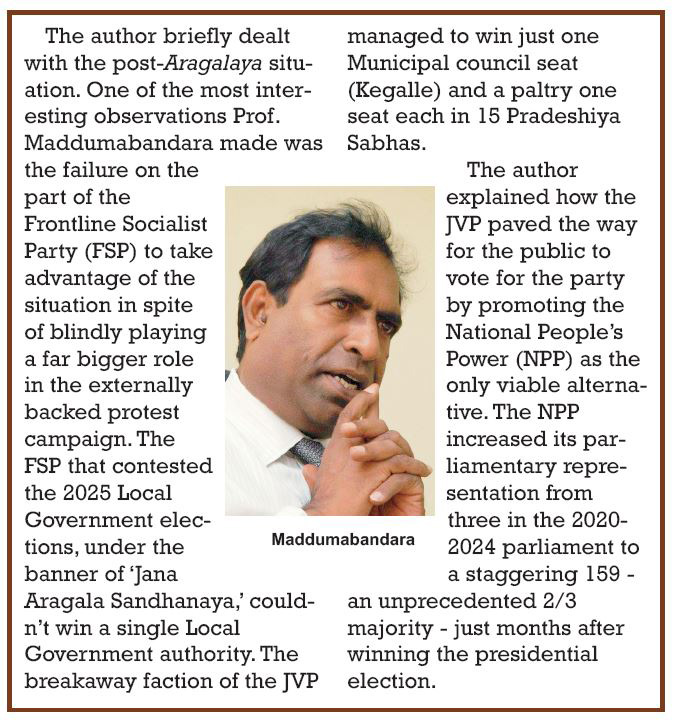
Absence of investigations
Sri Lanka never really wanted to probe the foreign backed political plot to seize power by extra-parliamentary means. Although some incidents had been investigated, the powers that be ensured that the overall project remained uninvestigated. In fact, Baglay’s name was never mentioned regarding the developments, directly or indirectly, linked to the devious political project. If not for Prof. Maddumabandara taking trouble to deal with the contentious issue of regime change, Baglay’s role may never have come to light. Ambassador Chung would have remained the target of all those who found fault with US interventions. Let me be clear, the revelation of Baglay’s clandestine meeting with the Speaker didn’t dilute the role played by the US in Gotabaya Rajapaksa’s removal.
If Prof. Maddumabandara propagated lies, both the author and Abeywardana should be appropriately dealt with. Aragalaye Balaya failed to receive the desired or anticipated public attention. Those who issue media statements at the drop of a hat conveniently refrained from commenting on the Indian role. Even Abeywardena remained silent though he could have at least set the record straight after Ambassador Chung was accused of secretly meeting the Speaker. Abeywardena could have leaked the information through media close to him. Gotabaya Rajapaksa and Ranil Wickremesinghe, too, could have done the same but all decided against revealing the truth.
A proper investigation should cover the period beginning with the declaration made by Gotabaya Rajapaksa’s government, in April 2022, regarding the unilateral decision to suspend debt repayment. But attention should be paid to the failure on the part of the government to decide against seeking assistance from the International Monetary Fund (IMF) to overcome the crisis. Those who pushed Gotabaya Rajapaksa to adopt, what they called, a domestic solution to the crisis created the environment for the ultimate collapse that paved the way for external interventions. Quite large and generous Indian assistance provided to Sri Lanka at that time should be examined against the backdrop of a larger frightening picture. In other words, India was literally running with the sheep while hunting with the hounds. Whatever the criticism directed at India over its role in regime change operation, prompt, massive and unprecedented post-Cyclone Ditwah assistance, provided by New Delhi, saved Sri Lanka. Rapid Indian response made a huge impact on Sri Lanka’s overall response after having failed to act on a specific 12 November weather alert.
It would be pertinent to mention that all governments, and the useless Parliament, never wanted the public to know the truth regarding regime change project. Prof. Maddumabandara discussed the role played by vital sections of the armed forces, lawyers and the media in the overall project that facilitated external operations to force Gotabaya Rajapaksa out of office. The author failed to question Wickremesinghe’s failure to launch a comprehensive investigation, with the backing of the SLPP, immediately after he received appointment as the President. There seems to be a tacit understanding between Wickremesinghe and the SLPP that elected him as the President not to initiate an investigation. Ideally, political parties represented in Parliament should have formed a Special Parliamentary Select Committee (PSC) to investigate the developments during 2019 to the end of 2022. Those who had moved court against the destruction of their property, during the May 2022 violence directed at the SLPP, quietly withdrew that case on the promise of a fresh comprehensive investigation. This assurance given by the Wickremesinghe government was meant to bring an end to the judicial process.
When the writer raised the need to investigate external interventions, the Human Rights Commission of Sri Lanka (HRCSL) sidestepped the issue. Shame on the so-called independent commission, which shows it is anything but independent.
Sumanthiran’s proposal
Since the eradication of the Liberation Tigers of Tamil Eelam (LTTE) in May 2009, the now defunct Tamil National Alliance’s (TNA) priority had been convincing successive governments to withdraw the armed forces/ substantially reduce their strength in the Northern and Eastern Provinces. The Illankai Thamil Arasu Kadchi (ITAK)-led TNA, as well as other Tamil political parties, Western powers, civil society, Tamil groups, based overseas, wanted the armed forces out of the N and E regions.
Abeywardena also revealed how the then ITAK lawmaker, M.A. Sumanthiran, during a tense meeting chaired by him, in Parliament, also on 13 July, 2022, proposed the withdrawal of the armed forces from the N and E for redeployment in Colombo. The author, without hesitation, alleged that the lawmaker was taking advantage of the situation to achieve their longstanding wish. The then Speaker also disclosed that Chief Opposition Whip Lakshman Kiriella and other party leaders leaving the meeting as soon as the armed forces reported the protesters smashing the first line of defence established to protect the Parliament. However, leaders of minority parties had remained unruffled as the situation continued to deteriorate and external powers stepped up efforts to get rid of both Gotabaya Rajapaksa and Ranil Wickremesinghe to pave the way for an administration loyal and subservient to them. Foreign powers seemed to have been convinced that Speaker Abeywardena was the best person to run the country, the way they wanted, or till the Aragalaya mob captured the House.
The Author referred to the role played by the media, including social media platforms, to promote Gotabaya Rajapaksa’s successor. Maddumamabandara referred to the Hindustan Times coverage to emphasise the despicable role played by a section of the media to manipulate the rapid developments that were taking place. The author also dealt with the role played by the Janatha Vimukthi Peramuna (JVP) in the project with the focus on how that party intensified its actions immediately after Gotabaya Rajapaksa stepped down.
Disputed assessment
The Author identified Ministers Bimal Rathnayaka, Sunil Handunetti and K.D. Lal Kantha as the persons who spearheaded the JVP bid to seize control of Parliament. Maddumabanda unflinchingly compared the operation, mounted against Gotabaya Rajapaksa, with the regime change operations carried out in Iraq, Libya, Egypt and Ukraine. Asserting that governments loyal to the US-led Western block had been installed in those countries, the author seemed to have wrongly assumed that external powers failed to succeed in Sri Lanka (pages 109 and 110). That assertion is utterly wrong. Perhaps, the author for some unexplained reasons accepted what took place here. Nothing can be further from the truth than the regime change operation failed (page 110) due to the actions of Gotabaya Rajapaksa, Mahinda Yapa Abeywardana and Ranil Wickremesinghe. In case, the author goes for a second print, he should seriously consider making appropriate corrections as the current dispensation pursues an agenda in consultation with the US and India.
The signing of seven Memorandums of Understanding (MoUs) with India, including one on defence, and growing political-defence-economic ties with the US, have underscored that the JVP-led National People’s Power (NPP) may not have been the first choice of the US-India combine but it is certainly acceptable to them now.
The bottom line is that a democratically elected President, and government, had been ousted through unconstitutional means and Sri Lanka meekly accepted that situation without protest. In retrospect, the political party system here has been subverted and changed to such an extent, irreparable damage has been caused to public confidence. External powers have proved that Sri Lanka can be influenced at every level, without exception, and the 2022 ‘Aragalaya’ is a case in point. The country is in such a pathetic state, political parties represented in Parliament and those waiting for an opportunity to enter the House somehow at any cost remain vulnerable to external designs and influence.
Cyclone Ditwah has worsened the situation. The country has been further weakened with no hope of early recovery. Although the death toll is much smaller compared to that of the 2004 tsunami, economic devastation is massive and possibly irreversible and irreparable.
By Shamindra Ferdinando
Features
Radiance among the Debris
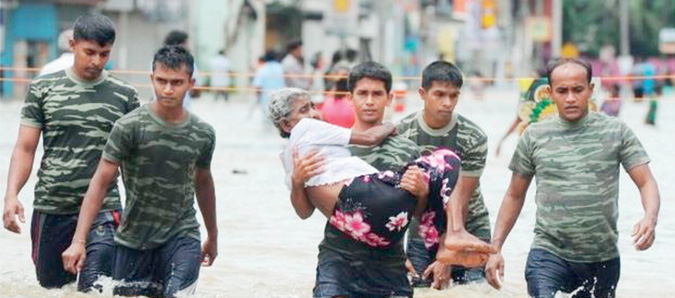
Over the desolate watery wastes,
Dulling the glow of the fabled Gem,
There opens a rainbow of opportunity,
For the peoples North and South,
To not only meet and greet,
But build a rock-solid bridge,
Of mutual help and solidarity,
As one undivided suffering flesh,
And we are moved to say urgently-
‘All you who wax so lyrically,
Of a united nation and reconciliation,
Grab this bridge-building opportunity.’
By Lynn Ockersz
-
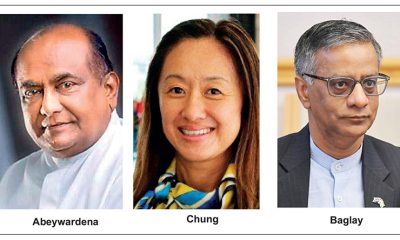
 Features4 days ago
Features4 days agoFinally, Mahinda Yapa sets the record straight
-

 News6 days ago
News6 days agoOver 35,000 drug offenders nabbed in 36 days
-
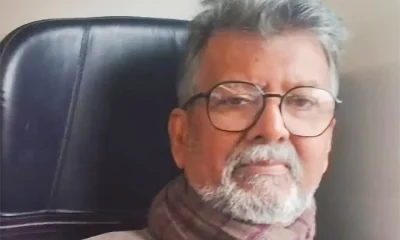
 News5 days ago
News5 days agoCyclone Ditwah leaves Sri Lanka’s biodiversity in ruins: Top scientist warns of unseen ecological disaster
-

 News6 days ago
News6 days agoRising water level in Malwathu Oya triggers alert in Thanthirimale
-
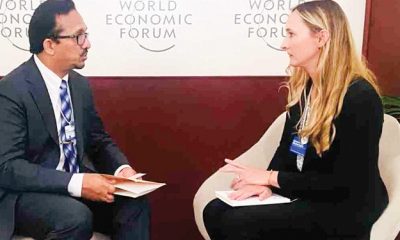
 Features4 days ago
Features4 days agoHandunnetti and Colonial Shackles of English in Sri Lanka
-

 Business3 days ago
Business3 days agoCabinet approves establishment of two 50 MW wind power stations in Mullikulum, Mannar region
-

 Business6 days ago
Business6 days agoSri Lanka betting its tourism future on cold, hard numbers
-

 News6 days ago
News6 days agoNew landslide alerts as Ditwah aftermath worsens













